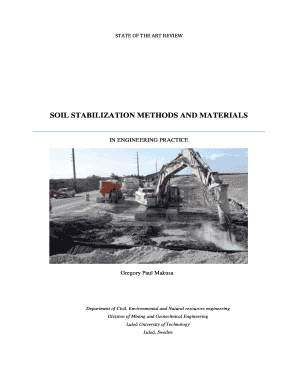Loading

Get Soil Stabilization Methods And Materials
How it works
-
Open form follow the instructions
-
Easily sign the form with your finger
-
Send filled & signed form or save
How to fill out the SOIL STABILIZATION METHODS AND MATERIALS online
Filling out the SOIL STABILIZATION METHODS AND MATERIALS form online can initially seem daunting, but with clear guidance, the process can be straightforward and efficient. This guide provides step-by-step instructions tailored to help users complete the form easily.
Follow the steps to complete the SOIL STABILIZATION METHODS AND MATERIALS form.
- Press the 'Get Form' button to access the SOIL STABILIZATION METHODS AND MATERIALS document and open it in your chosen online editor.
- Begin by entering the project title in the designated field. Ensure that the title is descriptive and accurately reflects the project at hand.
- In the section regarding soil types, select appropriate classifications by checking the boxes next to each type that applies to the stabilization project. If additional soil types need to be included, provide them in the comments section.
- For the stabilizing agents section, choose from the available options such as cement, lime, or fly ash by marking the corresponding checkboxes. If you intend to use a stabilizing agent not listed, specify it in the space provided.
- Complete the methodology description by detailing the soil stabilization methods that will be implemented. Use clear and concise language to outline the procedures you will follow.
- Fill out any additional considerations or notes relevant to the stabilization process, ensuring that you cover all aspects that may impact the project's success.
- Once all sections are completed, review the information for accuracy and completeness. Make any necessary edits before finalizing the document.
- Save your changes to the form. You can choose to download, print, or share the form as needed to ensure it reaches the appropriate stakeholders.
Complete your SOIL STABILIZATION METHODS AND MATERIALS form online today to effectively streamline your project.
Sisal Fiber This can be considered as one of the cheapest and effective way of soil reinforcement technique as it makes the use of natural resources. The fibers act as a thread to bind the soil particles together in the form of a coherent matrix which results in the increased strength and stability of soil masses.
Industry-leading security and compliance
US Legal Forms protects your data by complying with industry-specific security standards.
-
In businnes since 199725+ years providing professional legal documents.
-
Accredited businessGuarantees that a business meets BBB accreditation standards in the US and Canada.
-
Secured by BraintreeValidated Level 1 PCI DSS compliant payment gateway that accepts most major credit and debit card brands from across the globe.


